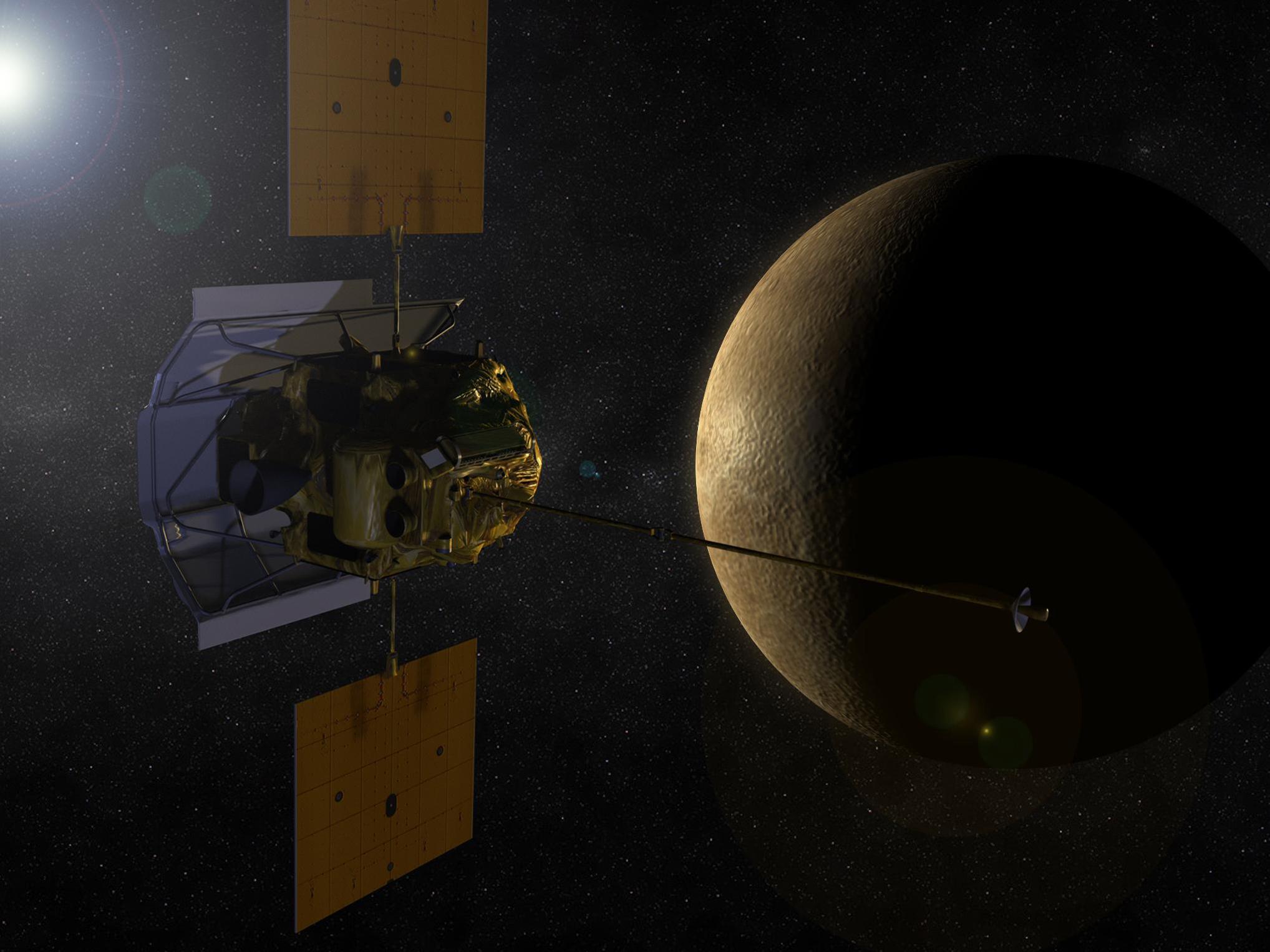Press Release
NASA Celebrates MESSENGER Mission Prior to Surface Impact of Mercury
Thu, 04/16/2015 - 13:31
NASA’s highly successful MErcury Surface, Space ENvironment, GEochemistry, and Ranging (MESSENGER) spacecraft is coming to the end of its operations. Mission engineers predict that the probe — out of fuel and under gravity’s spell — will impact Mercury on April 30 at more than 8,750 miles per hour (3.91 kilometers per second).
The spacecraft launched on August 3, 2004, and travelled more than six and a half years before it was inserted into orbit about Mercury on March 18, 2011. The original plan was to orbit the planet for one Earth year, collecting data to answer six critical questions. But new questions raised by early findings motivated two extensions of orbital operations for a total of three more years. Moreover, through a series of technological innovations, MESSENGER’s engineers devised a way to save fuel early on and leverage helium gas later, paving the way for a final one-month extension that enabled mission scientists to continue to acquire novel, low-altitude measurements of the planet closest to the Sun.
“MESSENGER had to survive heating from the Sun, heating from the dayside of Mercury, and the harsh radiation environment in the inner heliosphere, and the clearest demonstration that our innovative engineers were up to the task has been the spacecraft’s longevity in one of the toughest neighborhoods in our Solar System,” said MESSENGER Principal Investigator Sean Solomon, director of Columbia University’s Lamont-Doherty Earth Observatory. “Moreover, all of the instruments that we selected nearly two decades ago have proven their worth and have yielded an amazing series of discoveries about the innermost planet.”
“Although Mercury is one of Earth’s nearest planetary neighbors, astonishingly little was known when we set out,” Solomon continued. “MESSENGER has at last brought Mercury up to the level of understanding of its sister planets in the inner Solar System. Of course, the more we learn, the more new questions we can ask, and there are ample reasons to return to Mercury with new missions.”
In a briefing at NASA Headquarters today, MESSENGER scientists and engineers ticked off the top science findings and technological innovations from the mission. Near the top of the list of science accomplishments is having provided compelling support for the hypothesis that Mercury harbors abundant water ice and other frozen volatile materials in its permanently shadowed polar craters.
“The water now stored in ice deposits in the permanently shadowed floors of impact craters at Mercury’s poles most likely was delivered to the innermost planet by the impacts of comets and volatile-rich asteroids,” says Solomon. “Those same impacts also likely delivered the material in the dark layer discovered by MESSENGER to cover most polar deposits and interpreted, on the basis of its sublimation temperature and low reflectance, to be carbonaceous. By this interpretation, Mercury’s polar regions serve as a witness plate to the delivery to the inner solar system of water and organic compounds from the outer solar system, a process that much earlier may have led to prebiotic chemical synthesis and the origin of life on Earth. MESSENGER’s findings have made Mercury an even more interesting body for future exploration than before our mission.”
The technological innovations that grew out of the MESSENGER mission are equally impressive, said MESSENGER Project Manager Helene Winters and MESSENGER Mission Systems Engineer Daniel O’Shaughnessy, both of the Johns Hopkins University Applied Physics Laboratory in Laurel, Maryland.
Together, they presented the top 10 technology innovations, which included the development of MESSENGER’s first line of thermal defense, a heat-resistant and highly reflective ceramic cloth sunshade that isolates the spacecraft’s instruments and electronics from direct solar radiation.
“The front side of the sunshade routinely experiences temperatures in excess of 300°C (570°F), whereas the majority of components in its shadow routinely operate near room temperature (20°C or 68°F),” Winters explained. “The sunshade is extremely effective at isolating most of the vehicle from the Sun’s radiation, but reflected infrared radiation from Mercury greatly influences the temperatures of MESSENGER’s components behind the sunshade. The influence of Mercury is effectively managed with careful selection of vehicle orientation, to balance heating across the spacecraft, as well as an intricate system of heat pipes and radiators.”
On April 14, mission operators at APL completed the fifth in a series of orbit correction maneuvers designed to delay MESSENGER’s impact into Mercury. The last such maneuver is scheduled for April 24.
“Following this last maneuver, we will finally declare MESSENGER out of propellant, as this maneuver will deplete nearly all of our remaining helium gas,” O’Shaughnessy said. “At that point, the spacecraft will no longer be capable of fighting the downward push of the Sun's gravity. After studying the planet intently for more than four years, MESSENGER’s final act will be to leave an indelible mark on Mercury, as the spacecraft heads down to an inevitable surface impact.”
MESSENGER (MErcury Surface, Space ENvironment, GEochemistry, and Ranging) is a NASA-sponsored scientific investigation of the planet Mercury and the first space mission designed to orbit the planet closest to the Sun. The MESSENGER spacecraft was launched on August 3, 2004, and was inserted into orbit about Mercury on March 18, 2011 (UTC), to begin its primary mission — a yearlong study of its target planet. MESSENGER’s first extended mission began on March 18, 2012, and ended one year later. MESSENGER is now in a second extended mission, which is scheduled to conclude this spring. Sean C. Solomon, the Director of Columbia University’s Lamont-Doherty Earth Observatory, leads the mission as Principal Investigator. The Johns Hopkins University Applied Physics Laboratory built and operates the MESSENGER spacecraft and manages this Discovery-class mission for NASA.
